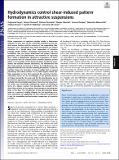Hydrodynamics control shear-induced pattern formation in attractive suspensions
Author(s)
Varga, Zsigmond; Grenard, Vincent; Pecorario, Stefano; Taberlet, Nicolas; Dolique, Vincent; Manneville, Sébastien; Divoux, Thibaut; McKinley, Gareth H; Swan, James W; ... Show more Show less
DownloadPublished version (1.604Mb)
Terms of use
Metadata
Show full item recordAbstract
© 2019 National Academy of Sciences. All rights reserved. Dilute suspensions of repulsive particles exhibit a Newtonian response to flow that can be accurately predicted by the particle volume fraction and the viscosity of the suspending fluid. However, such a description fails when the particles are weakly attractive. In a simple shear flow, suspensions of attractive particles exhibit complex, anisotropic microstructures and flow instabilities that are poorly understood and plague industrial processes. One such phenomenon, the formation of log-rolling flocs, which is ubiquitously observed in suspensions of attractive particles that are sheared while confined between parallel plates, is an exemplar of this phenomenology. Combining experiments and discrete element simulations, we demonstrate that this shear-induced structuring is driven by hydrodynamic coupling between the flocs and the confining boundaries. Clusters of particles trigger the formation of viscous eddies that are spaced periodically and whose centers act as stable regions where particles aggregate to form flocs spanning the vorticity direction. Simulation results for the wavelength of the periodic pattern of stripes formed by the logs and for the log diameter are in quantitative agreement with experimental observations on both colloidal and noncolloidal suspensions. Numerical and experimental results are successfully combined by means of rescaling in terms of a Mason number that describes the strength of the shear flow relative to the rupture force between contacting particles in the flocs. The introduction of this dimensionless group leads to a universal stability diagram for the log-rolling structures and allows for application of shear-induced structuring as a tool for assembling and patterning suspensions of attractive particles.
Date issued
2019Department
Massachusetts Institute of Technology. Department of Chemical Engineering; MultiScale Materials Science for Energy and Environment, Joint MIT-CNRS Laboratory; Massachusetts Institute of Technology. Department of Mechanical EngineeringJournal
Proceedings of the National Academy of Sciences of the United States of America
Publisher
Proceedings of the National Academy of Sciences